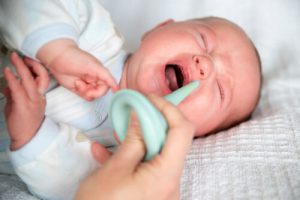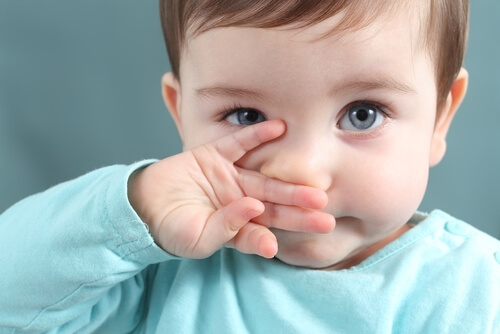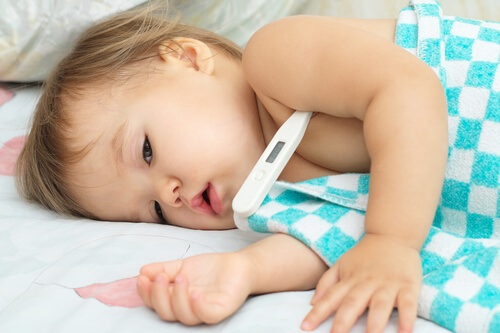How to Easily Remove Mucus From Your Child's Nose


Written and verified by the psychopedagogue María José Roldán
Because children don’t know how to blow their own nose, mucus can cause a lot of discomfort for them. That’s why we’ll teach you how to easily remove mucus from your child’s nose.
One of the concerns of parents with babies is preventing colds. A typical symptom of a cold is nasal congestion. But, although little ones commonly get sick, their illnesses must be taken seriously because they can lead to a more serious problem than a simple cold.
What you need to know to remove mucus from your child’s nose
First of all, it is important to know that it is common and normal for babies to have both mucus and phlegm, even if they do not have a cold.
Keep in mind that mucus is an effective defense mechanism for the body, since it is responsible for clearing the airways of germs and preventing them from spreading.
Thus, symptoms caused by an excess of mucus or phlegm are the following:
- Accumulation of mucus in the respiratory tract causes coughing, sneezing, deafness and difficulty breathing
- In the event that phlegm reaches the throat, the baby can begin gagging and vomiting.
- Diarrhea is also common for babies with excessive mucus. This is because the baby tends to swallow the mucus and expel it in his stool.
Coughing actually works as a defense mechanism for the body. It serves to mobilize mucus from the lower respiratory tract and expel it. It is therefore good for a child to cough, and we should not immediately resort to medications to calm the cough.

In the event that the cough is excessive and does not allow the child to rest, it is advisable to go to the pediatrician to indicate the necessary measures.
The problem of excessive mucus
A problem arises when mucus is excessive, because it can make the child feel very uncomfortable. If this condition lasts for a long time, it can cause otitis, so it is best to try to resolve the matter as soon as possible.
Medical treatment
If your child is very small, do not resort to medical treatment too quickly. Keep in mind that pediatricians are not in favor of prescribing mucus reducers to babies. Although they do dissolve the mucus and promote its expulsion, they increase the secretion of mucus.
This, in the end, establishes a vicious cycle that is not easy to get out of. Even if you don’t believe this, medicating your baby each time he has mucus or phlegm can be more harmful than actually having mucus.
Water: a great ally for eliminating mucus
Water can be your best ally if your baby has mucus. Try to have him drink a lot, because the liquid will help dissolve the mucus.
You should try to create a humid environment and avoid areas full of smoke. Use a humidifier, vaporizer or containers filled with water.
Help your child clear his nose
To help your child clear his nose, you will need to clean the mucus away with a soft cloth and wash his nose with a saline solution. To apply the solution, it is best to have your child lay on his side so that he avoids swallowing the mucus. Put the wash in one nostril while gently pressing the other.
Nasal bulbs can also help you remove mucus from your child’s nose. If you prefer this option, don’t do it more than twice a day or you will end up irritating his nose.

Caring for the mouth
Just as it is important to clean the nose, it is important to do the same with the mouth. Keep in mind that since they are so small, babies often do not have enough strength to cough, and the phlegm remains in their mouths. You must help them avoid swallowing it again.
So when the baby coughs, help him expel the phlegm by rolling sterile gauze onto your index finger and putting it in his mouth. The phlegm will stick to the gauze and it will be easier to remove it.
Do not force him to eat
It is important that you do not force your child to eat. Both nasal congestion and phlegm can cause a loss of appetite, nausea and vomiting. So be patient and let him eat when he feels like it. If you force him to eat, he will end up vomiting.
If necessary, it is preferable to eat more often throughout the day but in smaller portions. This way he can get enough to eat without experiencing the sensation of drowning when eating.
Although you will not be able to prevent your child from catching a cold at least once a year, it is good to put into practice the measures described above so that the discomforts affect them as little as possible.
All cited sources were thoroughly reviewed by our team to ensure their quality, reliability, currency, and validity. The bibliography of this article was considered reliable and of academic or scientific accuracy.
- American Academy of Allergy, Asthma, and Immunology. (s.f.). Humidifiers and indoor allergies. Consultado el 17 de abril de 2023. https://www.aaaai.org/tools-for-the-public/conditions-library/allergies/humidifiers-and-indoor-allergies
- Baquerizo Campuzano, K. G., & Castello Gutiérrez, L. M. (2019). Técnicas de higiene bronquial y su aplicación en el tratamiento de afecciones respiratorias en niños de etapa preescolar, consulta externa, Hospital Dr. José Cevallos Ruiz, Yaguachi, Guayas octubre 2018-abril 2019. BABAHOYO: UTB, 2019.
- C. Barth, Patrick. (s.f.). Lesiones de tímpano. Nemours KidsHealth. Consultado el 17 de abril de 2023. https://kidshealth.org/es/parents/eardrums.html
- Chirico, G., Quartarone, G., & Mallefet, P. (2014). Nasal congestion in infants and children: a literature review on efficacy and safety of non-pharmacological treatments. Minerva pediatrica, 66(6), 549–557. https://pubmed.ncbi.nlm.nih.gov/25336097/
- Figueredo de Lima, Mónica et al. (2020). Nasal wash. Always the same? XII Manual Argentine Association of Ent & Pediatric Phonoaudiology. World Congress of Pediatric ent Buenos Aires, April 2019, 90-95. http://aaofp.org.ar/manual_12.pdf#page=91
- Marchisio, P., Picca, M., Torretta, S., Baggi, E., Pasinato, A., Bianchini, S., Nazzari, E., Esposito, S., & Principi, N. (2014). Nasal saline irrigation in preschool children: a survey of attitudes and prescribing habits of primary care pediatricians working in northern Italy. Italian Journal of Pediatrics, 40(1), 47. https://doi.org/10.1186/1824-7288-40-47
- Martín-Aragón, S., & Benedí, J. (2004). Farmacoterapia mucolítico-expectorante. Farmacia profesional (Internet), 18(1), 44–49. https://www.elsevier.es/es-revista-farmacia-profesional-3-articulo-farmacoterapia-mucolitico-expectorante-13057200
- National Library of Medicine. (s.f.). Stuffy or runny nose – children. Consultado el 17 de abril de 2023. https://medlineplus.gov/ency/article/003051.htm
- University of Utah Health. (2018). The skinny on snot: what your child’s mucus says about their health. Consultado el 17 de abril de 2023. https://healthcare.utah.edu/the-scope/kids-zone/list/2018/11/skinny-snot-what-your-childs-mucus-says-about-their-health
- Nationwide Children’s Hospital. (s.f.). Using a Nasal Spray for your Child. Consultado el 17 de abril de 2023. https://www.nationwidechildrens.org/family-resources-education/health-wellness-and-safety-resources/resources-for-parents-and-kids/how-to-use-an-epipen/epinephrine-myths-and-facts/using-a-nasal-spray-for-your-child
- Nationwide Children’s Hospital. (s.f.). Suctioning the Nose with a Bulb Syringe. Consultado el 17 de abril de 2023. https://www.nationwidechildrens.org/family-resources-education/health-wellness-and-safety-resources/helping-hands/suctioning-the-nose-with-a-bulb-syringe
- Wu, A. C., Dahlin, A., & Wang, A. L. (2021). The role of environmental risk factors on the development of childhood allergic rhinitis. Children (Basel, Switzerland), 8(8), 708. https://doi.org/10.3390/children8080708
This text is provided for informational purposes only and does not replace consultation with a professional. If in doubt, consult your specialist.








